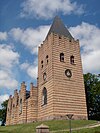Gottlieb Bindesbøll

Michael Gottlieb Birkner Bindesbøll (born September 5, 1800 in Ledøje on Zealand ; † July 14, 1856 in Copenhagen , according to another source in Frederiksberg ) was a Danish architect , construction clerk and brief lecturer at the Royal Danish Academy of Art in Copenhagen.
Life
Gottlieb Bindesbøll was originally supposed to learn and practice a craft. After he was influenced by Caspar Frederik Harsdorff's “pure classicism” buildings from his earliest youth , he went on a study trip through Germany and France in 1822/1823 . In France he got to know Franz Christian Gau , who pointed out to him in particular the ancient architecture and the submerged Pompeii . He then went on to study architecture at the Art Academy in Copenhagen. As a result, Bindesbøll settled in Copenhagen as an architect. In 1833 he received the CF Hansen Medal .
From 1834 to 1838 Bindesbøll then went on a second study trip that took him to Pompeii and Greece , where he studied ancient architecture in greater detail. He developed the first studies for the Thorvaldsen Museum in honor of Bertel Thorvaldsen . The building, which was completed over a period of almost a decade, is his main work. With the completion of the museum in 1847, he took up a position as a building inspector in the Duchy of Holstein , which belongs to Denmark , from where he moved to Jutland in the same position in 1849 , before moving in 1851 returned to Copenhagen. In the year of his death, he was appointed professor at the local art academy.
Bindesbøll, who was regarded as a reformer of Danish architecture at the reception , had a great gift for decoration. His work was just as influential in the development of Danish art. And that although he practically did not train his own students. He repeatedly used stylistic features of older designs. From the Renaissance in the town halls in Thisted and Stege or the Gothic (church in Hobro). For the expansion of the seaside resort Klampenborg near Copenhagen, he translated the English cottage style into Danish in 1844 . From 1849–1854 he designed several station buildings for the Flensburg – Husum – Tönning railway line , of which those in Husum and Schwesing are still preserved, while the first building at Flensburg train station , which went into operation in 1855, was replaced in 1886 by a successor by Johannes Otzen .
His son was Thorvald Bindesbøll .
Works
In addition to the above-mentioned high-rise buildings, Bindesbøll also emerged with designs for tools, grave monuments and other small objects.
| Construction year | place | address | image | object | measure | Remarks |
|---|---|---|---|---|---|---|
| 1838-1847 | Copenhagen |  |
Thorvaldsen Museum | New building | ||
| 1844 | Klampenborg |  |
Expansion of the seaside resort | New building | Den Røde Cottage | |
| 1847 | Copenhagen | Thing and detention house | New building | |||
| 1849-1854 | Flensburg – Husum – Tönning railway line |  |
Drafts for the high-rise buildings at the stations | New buildings | ||
| 1850-1852 | Hobro |  |
church | New building | ||
| 1853 | Thisted | town hall | New building | |||
| 1854 | Bridges |  |
town hall | New building | ||
| 1854 | Copenhagen Brumleby |  |
Creation of a district | |||
| 1855 | Copenhagen | Agricultural school | New building | |||
| Copenhagen | Unexecuted design for a zoological museum | draft |
literature
- Peter Thule Kristensen: Gottlieb Bindesbøll. Denmark's First Modern Architect. Architectens Forlag, Copenhagen 2013, ISBN 978-87-7407-407-6 .
- V. Lorenzen: Bindesböll, Michael Gottlieb Birkner . In: Ulrich Thieme , Felix Becker (Hrsg.): General Lexicon of Fine Artists from Antiquity to the Present . Founded by Ulrich Thieme and Felix Becker. tape 4 : Bida – Brevoort . Wilhelm Engelmann, Leipzig 1910, p. 38 ( Textarchiv - Internet Archive ).
- V. Lorenzen: Bindesböll, Thorvald . In: Ulrich Thieme , Felix Becker (Hrsg.): General Lexicon of Fine Artists from Antiquity to the Present . Founded by Ulrich Thieme and Felix Becker. tape 4 : Bida – Brevoort . Wilhelm Engelmann, Leipzig 1910, p. 38 ( Textarchiv - Internet Archive ).
Web links
Individual evidence
- ↑ Michael Gottlieb Birkner Bindesbøll. In: arch INFORM .
- ↑ a b c d e f g h i j k l V. Lorenzen: Bindesbøll, Michael Gottlieb Birkner.
- ^ Holger Kaufhold, Eckhard Klein, Detlef Schikorr: 150 Years of the Railway in Flensburg; From the Southern Schleswig Railway to the Bahn AG. Berlin 2004, ISBN 3-935909-22-5 , p. 20 ff.
- ↑ kulturarv.dk
- ↑ realdaniabyg.dk
- ↑ moen-atlas.dk
| personal data | |
|---|---|
| SURNAME | Bindesbøll, Gottlieb |
| ALTERNATIVE NAMES | Bindesbøll, Michael Gottlieb Birkner (full name) |
| BRIEF DESCRIPTION | Danish architect and university professor |
| DATE OF BIRTH | 5th September 1800 |
| PLACE OF BIRTH | Ledøje , Zealand |
| DATE OF DEATH | July 14, 1856 |
| Place of death | Copenhagen |